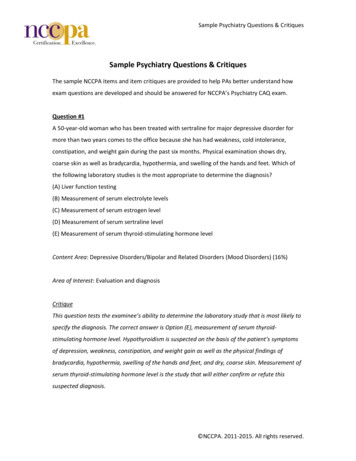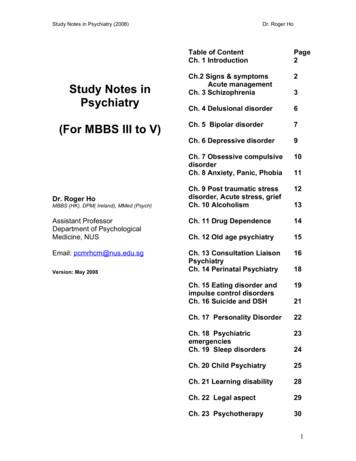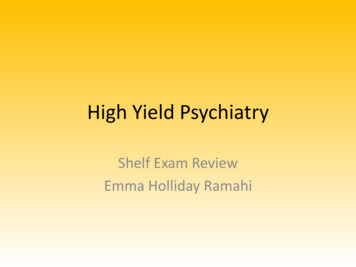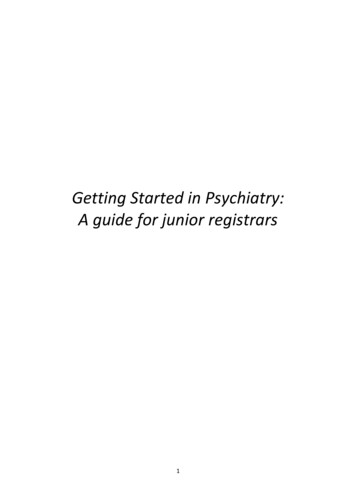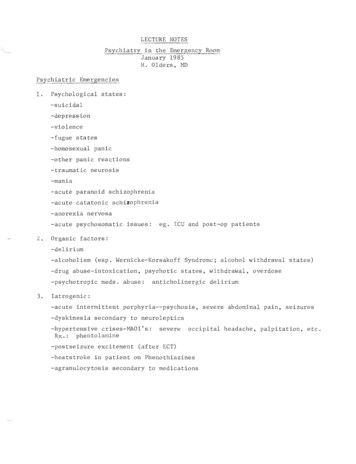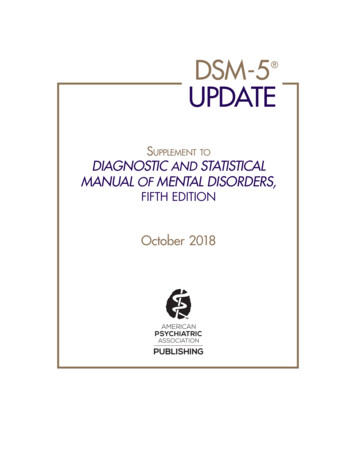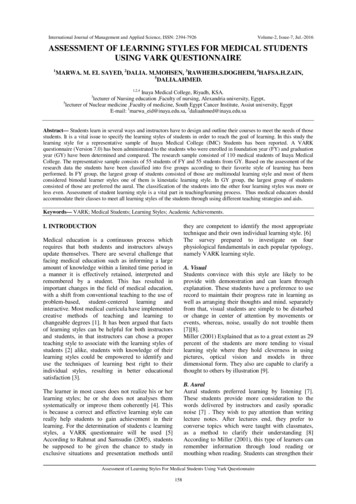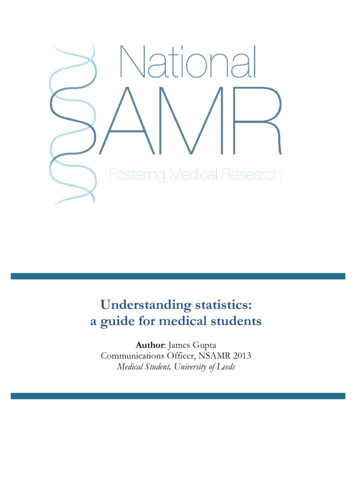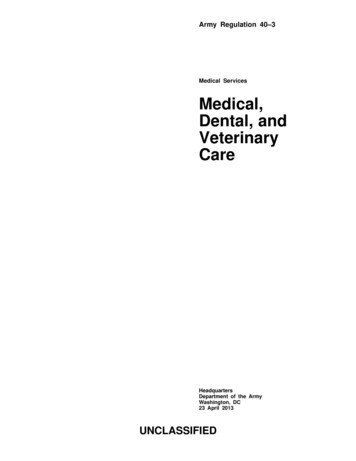
Transcription
PSYCHIATRYforMedical Students and ResidentsNabeel Kouka, MD, DO, MBANew Jersey, USAAugust 2009www.brain101.info
CONTENTSClassification & DSM-IV1Mental Status Examination2Interviewing Techniques3Psychiatric Tests3Psychodynamic Theories4Psychodynamic Psychotherapy5CNS Development7Childhood Development8Childhood Disorders13Psychotic Disorders20Mood Disorders23Anxiety Disorders27Cognitive Disorders31Personality Disorders36Somatoform Disorders39Dissociative Disorders42Adjustment Disorders44Impulse Control Disorders45Eating Disorders47Sleep Disorders49Sexual Disorders54Substance Related Disorders58Psycho-Pharmacology62Pain Management75Psychiatric Interventions77Legal Issues78www.brain101.info
PSYCHIATRYClassification!!!!!!Biological Psychiatryo Physiological & Neurochemical imbalanceo Treatment: Medications &/or ECTPsychodynamic Psychiatryo Psychological Stresseso Treatment: Psychotherapy &/or PsychoanalysisPsychosiso Impaired Reality Testingo Thought Disorders! Content (Delusions)! Process (Loose Associations)Neurosiso No abnormal Reality / Behavioro Ex: Mild Depression, Sexual Dysfunction, Anxiety DisorderOrganic Disordero Clear Medical Etiologyo Ex: Drug ToxicityFunctional Disordero No identifiable Medical Etiology / Pathophysiologyo Ex: SchizophreniaDSM-IV!!!!!!1Analyze symptomsDiagnostic features: Course of illness & Exclusion CriteriaDiagnostic reliability: Concordance between physicians’ diagnoses of same patientLack of validityGuidelineso Precedence to conditions due to Substance Abuse &/or Medical problemso DO NOT give separate Dx for minor disorderMain Axiseso Axis I: Majority of Diagnoseso Axis II: Disorders of Personality & Retardationo Axis III: Any other Medical Conditions (related or not)o Axis IV: Environmental &/or Psychosocial problemso Axis V: Global Assessment of Functioning (GAF)! Psychological, Social & Occupational functions! NOT Physical functions! Scored 1-100o V-codes: No Diagnosis in Axis I or Axis II! Used for problems w/o disorder! Ex: Relational problems (Marital), Abuse/Neglect (Physical, Sexual)www.brain101.info
Mental Status Examination!The mental status examination is used to describe the clinician’s observations &impression of the patient during the interview. In conjunction with the history of thepatient, it is the best way to make an accurate diagnosis.!General Descriptiono Appearance: grooming, poise, clothes, body type (disheveled, neat, childlike)o Behavior: quantitative & qualitative aspects of motor behavior (restless, tics)o Attitude toward the examiner: (cooperative, frank & seductive)Speecho The physical characteristics of speech (Rate, clarity, volume, rhythm,relevancy, coherency, fluency)Mood & Affecto Mood: Predominant emotional state of patient (depressed, anxious, angry)o Affect: Expression of patient’s present emotional responsiveness,appropriateness, variability (range; labile), intensity (blunted, flat)o Congruent - when Mood & Affect are the sameo Incongruent - when Mood & Affect are opposite each otherThoughto Form (Process) of thought! The way in which a person thinks (flight of ideas, loose associations,Tangentially “point of conversation never reached” & circumstantiality)o Content of thought! What the person thinking about (delusions, idea of reference, thoughtinsertion/withdrawal, broadcasting, paranoia, obsession, compulsion,phobia, suicidal ideas)Appropriatenesso In reference to the context of the subject (appropriate or inappropriate)Perceptual Disturbanceso Experienced in reference to self or the environment (hallucinations, illusions,dissociative states “depersonalization & derealization”)Sensorium & Cognition (Mini Mental Status Exam)o Alertness & level of Consciousness: (awake, clouding of consciousness, etc.).o Orientation: time, place, and person.o Concentration & Attention: serial sevens, serial threes, spell backwardso Memory: recent, remote, recent past, and immediate retention and recall.o Language (Read & Write): Ability to read a sentence & perform what it sayso Visuospatial Ability: Copy a figure! Lost in Construction Apraxia (Non-dominant Partial)o Abstract Thinking: similarities and proverb interpretationo Fund of information and knowledge: calculating ability, name past presidentsImpulse Controlo Estimate in history or behavior during the interviewJudgment & Insighto Ability to act appropriately and self-reflectReliabilityo Ability to accurately assess his/her situation!!!!!!!!!2www.brain101.info
Interviewing Techniques!!!!!!Open-Ended Questionso Allow the patient to speak in his own words as much as possibleo Not YES or NO answers: “Can you tell me about the voices?”Closed-Ended Questionso Ask for specific information without allowing options in answeringo YES or NO answers: “Are you hearing voices?”Facilitationo Physician helps the patient continue by providing verbal and nonverbal cueso “Yes, please, continue”Confrontationo Physician points something out to the patiento “You are very upset today”Reassuranceo If truthful, can lead to increased compliance! “We both know that what you have is serious” - Truthfulo If false, can lead to decreased compliance! “Everything will be alright” - FalseLeadingo The answer is suggested in the questiono “Are voices telling you to hurt yourself?”Psychiatric TestsIntelligence Tests! Intelligence Quotient (IQ) measures academic performanceIQ MA / CA X 100MA Mental Age (Performance Score)CA Chronological Age (Actual Age)Mean IQ 100 1 SD(SD 15)! Adultso Wechsler Adult Intelligence Scale Revised (WAIS-R)! Childreno Wechsler Intelligence Scale for Children Revised (WISC-R)! For children 6 yoo Stanford-Binet: Intelligence Scales (First IQ test developed)! For young children 6 yoPersonality Tests! Objective Tests: Use simple stimuli & do not need much clinical experienceo Minnesota Multiphasic Personality Inventory (MMPI)! Projective Tests: Use ambiguous stimuli, need clinical experience, not diagnostico Rorschach Test (inkblot)o Thematic Apperception Test (TAT)o Sentence Completion Testo Drawings! Neuropsychologic Tests: Used to detect organicity from any psychiatric disorder:o Bender-Gestalto Luria-Nebraskao Halted-Reitan3www.brain101.info
Psychodynamic TheoriesDrive Theories!!!!Internal drives give rise to thoughts, feelings, behaviorsProblems arise when drives conflictPsychoanalytic: Freud " sex, pleasure, hunger, aggression, avoidance of paino Topographical model: Conscious, preconscious, unconsciouso Psychosexual development: oral, anal, phallic, latency, genitalo Structural model! Id (Unconscious Drives/Instincts - Sex & Aggression): Present at birth! Ego (Rational/Abstract Thought, Defense Mechanisms, Judgment,Objective Relationships): Developed shortly after birth! Superego (Moral Conscience): Formed during latency period. (Right& Wrong)Analytic Psychology: Jung; shared symbolic past formso Collective unconscious (structure)o Archetypes: Concepts the brain is preprogrammed to useo Complexes formed from interactions of archetypes with individual experience,tested by free association (time to respond)Relationship Theories!!!!Thoughts, feelings, behaviors are driven by need for attachment to othersObject Relationso Klein (infant mother-object)o Bowlby (attachment-separation; parent child)Interpersonal therapyo Sullivan; interpersonal forces important for developmentSelf-Psychologyo Kohut: Create cohesive sense of self through empathic interactions w/ parents& othersHumanistic Theories!!!Each individual has potential for autonomous function, growth & self-actualization(become who you truly are)Client-centered Therapyo Rogers: individual strives for self-actualizationo Helped by therapists w/ unconditional positive regard for patientExistential therapyo May; authenticity of patient & therapist crucial for developmentDevelopmental Theories!4Personal growth occurs in series of developmental stageso Psychosocial Theory - Erickson (Lifelong)! Integrity vs. Despair! Major depression in 65 y.o. age groupo Cognitive Theory - Piaget (Children)www.brain101.info
Psychodynamic PsychotherapyDEFENSE MECHANISMS!!!!!!The way & means that the Ego wards off anxiety & controls instinctive, urges &unpleasant affects (Emotions)All Defense Mechanisms are Unconscious (except Suppression), Discrete, Dynamic& Irreversible, Adaptive & MaladaptiveHighly adaptive (mature)o Altruism, Humor, Sublimation & SuppressionLess adaptiveo Displacement, Intellectualization, Isolation of Affect, Rationalization,Reaction Formation & RepressionPrimitive (immature)o Acting out, Denial (deletion from consciousness), Projection & SplittingTransference & Countertransferenceo Brings unconscious topics into consciousnesso Transference! Feelings of patient toward therapist! Occurs in all patient/physician relationshipso Countertransference! Feelings of therapist toward patient! Occurs in all patient/physician relationshipso Interpretation! Therapist identifies feelings, drives, and defenses in actionTypes of Defense Mechanisms!!!!!5Projectiono Attributing your own wishes, thoughts, or feelings onto someone elseo Usually seen in Paranoid Personalityo “I’m sure my wife is cheating on me”Denialo Used to avoid becoming aware of some painful aspect of realityo “I know I do not have cancer”o The next step in management! If patient continue treatment: Do Nothing! If patient refuse treatment: Find out why & confrontSplittingo External objects are divided into all good or all bado Usually seen in Borderline Personality Disordero “The morning staff is much better than the evening staff”Blockingo Temporary block in thinkingo “I can’t seem to remember his name”*** Regression (The Least Mature “Most Immature” D.M.)o Return to an earlier stage of developmento “Older person acting as a child”! “Ever since my divorce, my 5-year-old has begun to wet the bed”www.brain101.info
!!!!!!!!!!!!!!6Somatizationo Psychic derivatives are converted into bodily symptomso “Just thinking of the exam I get butterflies in my stomach”o Somatoform Disorder - Usually seen in DepressionIntrojectiono Features of the external world are taken and made part of the selfo Opposite to Projectiono “The resident physician dresses like the attending”Displacemento An emotion or drive that is shifted to another that resembles the originalo Usually seen in Phobiaso “My husband kicked the dog every time we had an argument”Repressiono An idea or feeling is withheld from consciousness (unconscious forgetting)o “I do not remember having had a dog”*** Suppression (The only Conscious D.M.)o Conscious forgettingo “I would rather forget that my dog was run over by a car”Intellectualizationo Excessive use of intellectual processes to avoid affective experienceo Used to decrease anxietyo “It is interesting to note the specific skin lesions which seem to arise as aconsequence of my end-stage disease”Isolationo Separation of an idea from the affect that accompanies ito Horrible thing happened & person don’t show emotion, as if nothing happenedo “As she arrived to identify the body, she appeared to show no emotion”Rationalizationo Rational explanations used to justify unacceptable attitudes or behaviorso “I did not pass the test because it was very difficult”Reaction Formationo An unacceptable impulse is transformed into its oppositeo Results in the formation of character traitso “Listen to him telling he was not afraid, when I saw him crying”Reaction Formationo Thoughts of an unacceptable behaviorso Reaction Formation Obsession “thoughts” in OCDUndoingo Acting out the reverse of an unacceptable behavioro Undoing Compulsion “Acts” in Obsessive Compulsive Disordero “I need to wash my hands whenever I have these thoughts”Acting outo Behavioral or emotional outbursto “I can't explain why he has those temper tantrums”Humoro Permits the expression of feelings & thoughts without personal discomfort*** Sublimation (The Most Mature D.M.)o Impulse gratification has been achieved, but the aim or object has beenchanged from unacceptable to acceptable; allows instincts to be channeledo “Jack the Ripper becomes a surgeon”www.brain101.info
CNS DevelopmentCRITICAL DEVELOPMENT PERIODS!As you develop, you make more and neuronal (synaptic) interconnections, utilizingfewer and fewer neurons. That is, many neurons undergo apoptosis after initialneonatal period.o 2nd and 3rd trimesterso 8 months - 2 yrs oldo 6-7 yearso 8-9 yearsHARLOW’S MONKEYS!!Experiments raising monkeys in different environments and observing them as adults.Three conditions were set up:o Raised in bare-wire cage, artificial nipple, wooden armature & source of food:! The monkeys diedo Raised in similar cage, but arm and nipple were covered by terry cloth,providing snugly cutaneous touch:! They survived to become antisocial but had no reproductive successo Raised as in (2) but they saw a picture of a simple face reproductive success.They had more success than the other groups though! Grew up to be nerd monkeys and tried to interact with other monkeysbut had very little reproductive success. They had more success thanthe other groups though.CRECHE SYNDROME!!!Baby’s denied love in neonatal period have higher mortality & morbidity rateBaby’s raised in a prison where they were allowed to interact with their mothersthrived even better than the babies raised by an orphanage without such interactionTalking to baby’s is crucial for language developmentPARENTING!!Child should be able to engage parent's attention but should not have total controlover parent’s attention (for fear of manipulation)Child should have reasonable boundaries for undergoing exploratory behavior.CHILD & ADOLESCENT DEVELOPMENT!!!!7INFANCY (0-2 yrs): attachment, social smile (2 months), stranger anxiety (7-8months), oral stage, basic trust, sensorimotorPRESCHOOL (2-6 yrs): language, cognitive/motor skills, separation/individuation,negativity (“NO”), anal stage, Oedipal stage (dyad " triad)SCHOOL AGE (6-12 yrs): logic/reason (concrete operations), latency stage,in
PSYCHIATRY for Medical Students and Residents Nabeel Kouka, MD, DO, MBA New Jersey, USA August 2009 . www.brain101.info CONTENTS Classification & DSM-IV 1 Mental Status Examination 2 Interviewing Techniques 3 Psychiatric Tests 3 Psychodynamic Theories 4 .File Size: 715KBPage Count: 80
